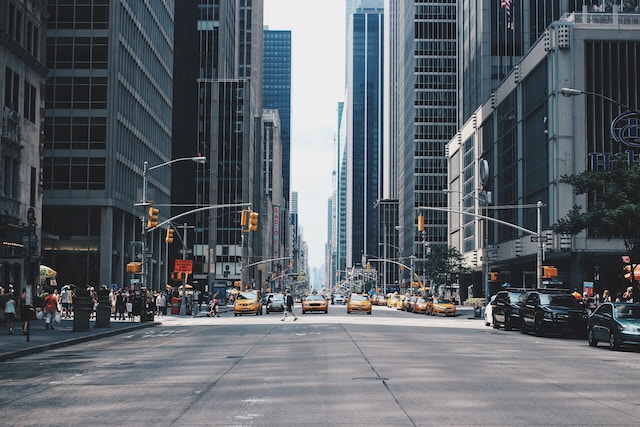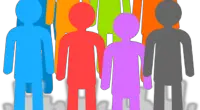In general, an avenue is a wide road or street, often lined with trees or other decorative elements, and typically runs perpendicular to streets. Streets, on the other hand, are generally narrower than avenues and typically run parallel to each other.
What is a street?
(Photo by Andrea Cau on Unsplash )

A street is a public thoroughfare that connects buildings and provides a route for transportation. Streets can be found in both urban and rural areas, and they often differ in their level of traffic congestion. Generally, streets are characterized by lower speeds than highways or freeways.
Streets typically have sidewalks on either side to provide safe passage for pedestrians, as well as curbs to separate the roadway from adjacent properties. They may also feature traffic signals, crosswalks, and parking spaces.
One interesting aspect of streets is that they often serve as the primary address for residential homes or businesses. Street names can reflect local history or cultural significance, such as Martin Luther King Jr Boulevard or Chinatown’s Grant Avenue.
While some streets may be bustling with activity throughout the day and night, others may be quiet and peaceful residential neighborhoods where children play outside with little disturbance from passing cars. Regardless of their location or purpose, streets play an important role in connecting communities together.
What is an avenue?
(Photo by H. Emre)

An avenue is a type of roadway that typically runs perpendicular to streets. Avenues are often wider and more grandiose than streets, featuring landscaped medians or wide tree-lined sidewalks. In many cities across the world, avenues are known for their grandeur and prestige, often hosting high-end shops, restaurants or cultural institutions.
Avenues also tend to be longer than streets as they generally run parallel to major transportation routes like highways or rivers. This makes them ideal for connecting different neighborhoods in a city while providing ample space for traffic flow.
In terms of naming conventions, avenues usually take on names that evoke sophistication and elegance such as Fifth Avenue in New York City or Champs-Élysées in Paris. These types of roadways have come to represent urban luxury and have become tourist attractions themselves.
An avenue is much more than just a simple roadway; it is an iconic symbol of metropolitan life that adds character and charm to any cityscape.
Avenue Vs. Street – Key differences
When it comes to navigating through a city, understanding the difference between an avenue and a street can be quite helpful. At first glance, both may seem interchangeable, but they have distinct characteristics that set them apart.
Generally speaking, streets are narrower and more straightforward than avenues. They tend to run perpendicular to avenues and are numbered or named after people or places. On the other hand, avenues tend to be wider and more expansive than streets. They usually run parallel to each other and are often lined with trees or grassy medians.
Another notable difference is in their usage. Streets typically serve as residential areas while avenues represent commercial zones that house businesses like shops and offices.
In terms of addresses, buildings on a street will likely have even numbers on one side of the road while odd numbers run along the opposite side. Avenues also follow this pattern but often include quadrant directions like Northeast (NE), Northwest (NW), Southeast (SE) or Southwest (SW).
Understanding these differences may not only help you navigate your way around town more efficiently but also give you insights into what kind of establishments you can expect along certain thoroughfares!
Examples of a Street
A street is a public road in a town or city that typically has buildings and houses along its sides. Streets can vary widely depending on their location, size, and purpose. Here are some examples of different types of streets:
- Residential streets are often found in residential areas with homes lining either side of the road, providing access to driveways and garages.
- Commercial streets are usually located in the heart of business districts where shops, restaurants, and other businesses have storefronts facing onto the sidewalk.
- Industrial streets tend to be located near factories or warehouses for easy transportation of goods using large trucks.
- Cul-de-sacs are dead-end streets that have no outlets at one end. These types of roads often provide privacy and limited vehicle traffic for residents who live there.
- One-way streets only allow traffic to flow in one direction which helps to reduce congestion and improve safety on busy roads.
These examples demonstrate how diverse and unique each street can be based on its environment.
Examples of an Avenue
Examples of an Avenue include some of the most famous streets in the world, such as Fifth Avenue in New York City or Rodeo Drive in Beverly Hills. These types of roads are typically wider than streets and lined with trees, making them a more pleasant walking experience.
In addition to being known for their shops and restaurants, avenues are often home to cultural landmarks like museums and theaters. For example, The Champs-Élysées is one of the most well-known avenues in Paris because it is home to several historic buildings including the Arc de Triomphe.
Avenues can also be found outside major cities where they serve as main thoroughfares connecting different neighborhoods. In these areas, they may not be lined with high-end stores but instead have commercial businesses like grocery stores and gas stations.
Some examples of notable avenues around the world include Park Avenue in New York City which runs through Manhattan’s Upper East Side neighborhood; Abbey Road in London which was made famous by The Beatles album cover photo; and Las Ramblas in Barcelona which is a popular tourist destination known for its street performers and cafes.
Avenues offer unique experiences that differ from streets due to their distinctive characteristics such as size, location or landmarks found along them.
How are streets and avenues named?
When it comes to naming streets and avenues, there are a few different methods that can be used. In some cases, they may be named after prominent historical figures or landmarks in the area.
Another common method is using an alphanumeric system where letters and numbers are assigned based on their location within the city. For example, streets running east-west might be designated by letters while north-south routes use numbers.
In some cities, particularly older ones like New York City, there can be inconsistencies with street names due to changes over time. This can make navigating challenging for visitors unfamiliar with the area.
Some communities have started to rename certain streets and avenues to reflect more modern values or honor underrepresented groups. This has been a controversial topic in some areas but reflects how street names can evolve along with society itself.
The process of naming streets and avenues varies depending on the city or town involved but always involves careful consideration of local history and culture.
What is a boulevard?
A boulevard is a wide, tree-lined street with multiple lanes of traffic. It’s often characterized by a central median or strip of greenery that separates the opposing lanes of traffic. Boulevards are typically found in urban areas and are designed to accommodate heavy volumes of vehicular traffic.
Boulevards can be more than just major thoroughfares, however. They’re often lined with shops, restaurants, and other businesses, giving them a lively and bustling atmosphere. In some cases, they may even include bike lanes or dedicated pedestrian walkways.
The term “boulevard” comes from the French word for “bulwark” or “fortification,” reflecting their original purpose as defensive structures around medieval cities. Over time, however, boulevards have evolved into vibrant cultural centers that reflect the character and personality of their surrounding communities.
Some famous examples of boulevards around the world include Paris’ Champs-Élysées; Mumbai’s Marine Drive; New York City’s Broadway; Barcelona’s Ramblas; and Los Angeles’ Wilshire Boulevard.
What is a road?
A road is a thoroughfare, route or way on land that connects two or more places. It can be made of concrete, asphalt, dirt or any other material suitable for transportation purposes. Roads are typically used by vehicles such as cars, trucks and buses to transport people and goods from one location to another.
Roads can vary in size and shape depending on their purpose and location. Some roads may be narrow and winding while others may be wide with multiple lanes for traffic flow. They can also have different speed limits depending on the area they are located in.
In rural areas, roads are often unpaved and used primarily for agricultural purposes or recreational activities like biking or hiking. In contrast, urban areas have a network of paved roads with sidewalks for pedestrians.
Maintaining roads is crucial to ensure safety for travelers as well as prevent damage to vehicles caused by potholes or uneven surfaces. Governments around the world invest heavily in building new roads as well as maintaining existing ones.
Roads play an essential role in our daily lives by facilitating transportation between different locations and improving mobility within communities.
Featured Image By – Edan Cohen on Unsplash








